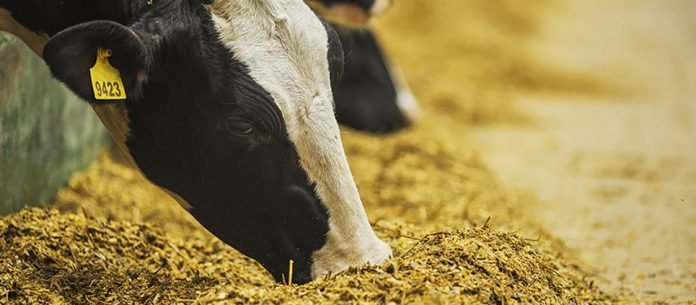INTRODUCTION
Zinc (Zn) is involved in many catalytic, co-catalytic, structural, and regulatory metabolic processes in animals. Its deficiency in dairy cattle leads to many disorders such as appetence, growth depression, inefficient feed utilization, reproductive failure, skeletal deformities, and immune system dysfunction,resulting finally in retarded growth, and lower milk synthesis. Organic Zn sources are coordinately bound Zn metal with an organic chelating ligand such as amino acids, carboxylates, proteinates, or carbohydrates. Minerals in free ionic forms may tend to interact with other minerals/ biomolecules in the gastric intestinal tract of animals and form water-insoluble complexes, which reduce their bioavailability. Mineral chelates resist these interactions by their strong covalent bonding with the ligand. Organic trace minerals are readily soluble and dissociate at intestinal pH, which makes metal ions available for better absorption. The dissociation rate of organic minerals from its ligand should be pH-specific for better bioavailability at the absorption site. Some mineral sources such as inorganic salts may dissociate too rapidly before it reaches the intestinal absorption site. This can lead to an association of metal ions with other anti-nutritional elements such as phytic acid, ascorbic acid, and tannins to form a highly insoluble metal complex that may excrete without being utilized by animals. Some mineral sources that are strongly chelated with ligands such as ethylenediaminetetraacetic acid complex may not dissociate throughout the gastrointestinal tract of animals leading to poor bioavailability. The rate of dissociation and bioavailability of organic chelates depends on the chelation strength or ligating effect of the metal complex. Thus, different Zn organic chelates exhibit different degrees of chelation which varies in their bioavailability and utilization in animals.
As zinc involvesin many structural, catalytic, intra – intercellular processes, Zn intestinal absorption or plasma Zn, and Zn in the liver alone cannot be considered as indicators of Zn status in the animal. Metallothionein (MET), a protein with Zinc moiety synthesized in various tissue to maintain hemostasis of Zn, is the true indicator of Zinc status in animals. Moreover, the activity of various antioxidant enzymes such as superoxide dismutase, catalase, and glutathione peroxidase are Zn dependent, and Zn playsa vital role in the total antioxidant status of the animal. Similarly, Zn participates in immune reactions and antibody synthesis. This study mainly focuses on the evaluation of various forms of zinc supplements in dairy cows on biochemical, immune, and metabolic roles.
MATERIALS AND METHODS
An in vivo trial was conducted on thirty Karan fries mid-lactating dairy cows (six animals/group) with three weeks of pretrial (PT) and 23 weeks of trial periods. The trial design followed aswitch-over pattern of the diet containing Zn supplementation and non-supplementation. There were three supplemental periods, S1 (Zn at 50ppm dosage for six weeks), S2 (Zn at 50ppm for three weeks), and S3 (Zn at 100ppm for three weeks). The non-supplementation period (no Zn supplementation) was followed for four weeks in between every supplemental period. During S1 and S3 periods, cows were shifted to metabolic stalls for seven days and metabolic trials were conducted to understand the bioavailability of Zn from different forms. In all, four types of Zinc supplements were tested, viz., the inorganic form of zinc, Zinc sulfate (ZnS), and organic forms of zinc, as Zinc glycinate (ZnG), Zinc propionate (ZnP), and Zinc methionates (ZnM). Of course, a control group was also included, in which animals had no exogenous Zn supplementation during the entire study. Apart from animal performance, the effect of Zn sources was mainly compared by their bioavailability (Intestinal absorption, Plasma Zn concentration), retention in the body (MET protein and its gene expression), their support on animal immunity (total immunoglobulins), and antioxidant status (ferric reducing antioxidant power of plasma).
RESULTS
SUMMARY
Average daily milk yield, and milk composition was similar between control and Zn supplemented animals. The differences were observed in lactation persistency and udder health. Organic Zn-supplemented animals showed longer and higher milk production than control animals. ZnP, ZnM supplemented animals recorded lower milk somatic cells than the control (Fig 2). As cellular transport of mineral ions follows an active transport mechanism, intestinal absorption of dietary Zn happens only with ionic form (Zn2+) with the assistance of zinc-binding proteins. Chelation strength and solubility of mineral chelates greatly influence the rate of dissociation and absorption in the animal gut. The current study data shows that the intestinal absorption of ZnP was highest than any other sources tested. The intestinal absorption level of ZnP, ZnG, ZnM, ZnS was 15.01%, 13.73%, 12.97%, 12.3% respectively at 100ppm dosage supplementation. ZnP supplementation showed highest bioavailability at 50ppm dosage. This result is aligned with the highest plasma Zn concentration, RBC Zn, MET protein, MET gene expression in blood, and immunoglobulin level in ZnP treated animals than other groups during the entire trial duration.
CONCLUSION
Zinc elements present in feed material alone will not be enough to meet the daily requirements of dairy animals. Exogenous supplementation of Zinc, at least 60 mg per kg of dry matter is necessary for dairy cows (National Research Council, 2021). Among the different sources tested, organic sources are better bioavailable than inorganic sources. Besides bioavailability, the effectiveness of organic Zn sources is significantly visualized than inorganic sources in various metabolic processes. The results of the present study confirm that ZnP supplementation showed a superior effect than any other Zn sources tested,with respect to all the aspects tested viz. bioavailability, retention, production, and performance efficiency in dairy cattle.
References are available on request.
by Shahid Hassan Mir, Veena Mani, Nitin Tyagi, Sudhir Singh, Emili Vinolya R, Balakrishnan U, and Santosh Vyas, National Dairy Research Institute, India, Kemin Industries South Asia Pvt. Ltd.











